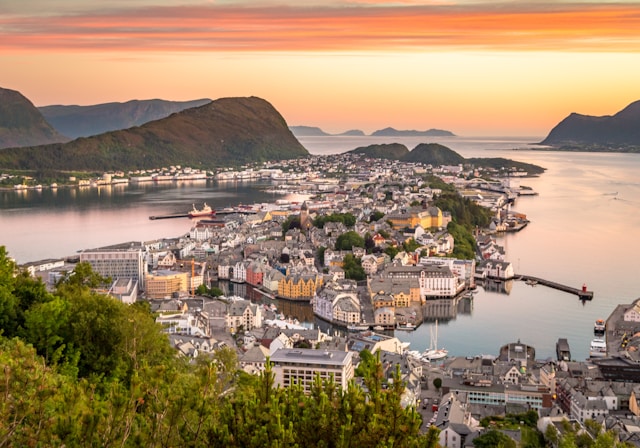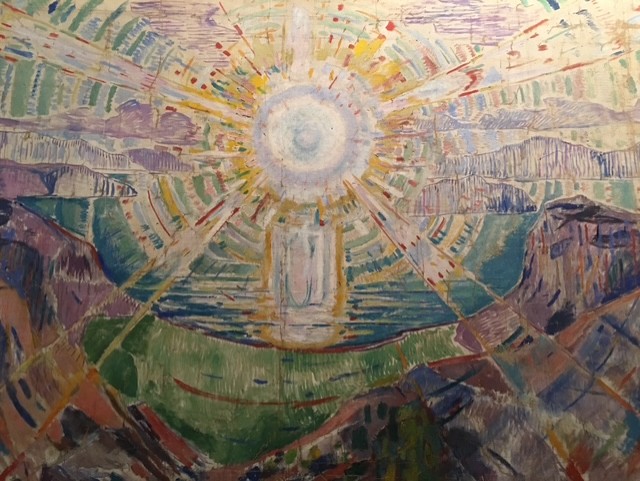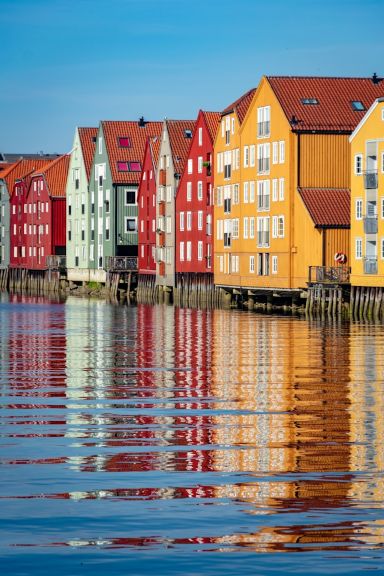Endelig (finally), here is my late July and August blog. I’m writing in English this time, but you’ll find plenty of Norwegian words, expressions, and names throughout, as well as a brief lesson on music (musikk) vocabulary and grammar.
 Summer in Norway - sommer i Norge - is packed with festivals, and one that I still haven’t had the chance to experience is the Jazz Festival in Molde; Moldejazz. (The word Moldejazz is an example of many Norwegian compound nouns; two Norwegian nouns put into one word). Moldejazz is held in Week 29 (uke 29) of July. In Norway, we often refer to the number of the week within the 52-week year. According to their website, Moldejazz is the oldest continuously running jazz festival in the world, having started in 1961. Moldejazz Website: https://www.moldejazz.no/ Also August brings lots of musikkfestivaler (music festivals), with Oslo hosting some big names, including Øyafestivalen, Oslo Kammermusikkfestival, Oslo Jazzfestival, and there is also OsloMatfestival (Oslo food festival).
Summer in Norway - sommer i Norge - is packed with festivals, and one that I still haven’t had the chance to experience is the Jazz Festival in Molde; Moldejazz. (The word Moldejazz is an example of many Norwegian compound nouns; two Norwegian nouns put into one word). Moldejazz is held in Week 29 (uke 29) of July. In Norway, we often refer to the number of the week within the 52-week year. According to their website, Moldejazz is the oldest continuously running jazz festival in the world, having started in 1961. Moldejazz Website: https://www.moldejazz.no/ Also August brings lots of musikkfestivaler (music festivals), with Oslo hosting some big names, including Øyafestivalen, Oslo Kammermusikkfestival, Oslo Jazzfestival, and there is also OsloMatfestival (Oslo food festival).
Music Vocabulary in Norwegian
If you want to talk about music (musikk), here are some useful words and phrases.
ei gruppe (a group)
et band (a band)
en kjent artist (a famous artist)
en sang (a song)
en låt (a tune)
en tekst (a lyric)
en melodi (a melody)
ei vise (a folk song)
en sanger (a singer)
en musiker (a musician)
en dirigent (a conductor)
et orkester (an orchestra)
en gitar (a guitar), et piano (a piano), trommer (drums)
Now, here are a few questions and answers you can use to practice your conversation skills:
Hva slags musikk liker du? Jeg liker klassisk musikk (eller jazz / pop / rock /visesang / klassisk / heavy metal / country / hiphop / blues /danseband).
(What kind of music do you like? I like classical music (or jazz, pop, rock, folk songs, heavy metal, country, hip hop, blues, and dance bands).
Har du noen norske favorittmusikere? Ja, jeg liker.....
(Do you have any favorite Norwegian musicians? Yes, I like.....)
Har du vært på konsert i Norge? Hvor var du? Når var det? Med hvem?
(Have you been to a concert in Norway? Where were you? When was it? With whom?)
And some useful verbs
Here are some common verbs (verb) in Norwegian and their conjugations across the four tenses: infinitive, present, past, and present perfect.
Å synge (to sing)
å synge – synger – sang – har sunget
Hun liker å synge (She likes to sing.)
Å høre på (to listen to)
å høre på – hører på – hørte på – har hørt på
Jeg hører på mye norsk musikk. (I listen to a lot of Norwegian music.)
Å gå på konsert/festival (to go to a concert/festival)
å gå på – går på – gikk på – har gått på
Vi går på jazzfestivalen i Oslo hvert år. (We go to the jazz festival in Oslo every year.)
Å spille (to play an instrument)
å spille – spiller – spilte – har spilt
Han har spilt piano i mange år. (He has played the piano for many years.)
Å like (to like)
Å like – liker – likte – har likt
Jeg liker norsk musikk. (I like Norwegian music.)
A Cultural Note on Summer in Norway
The long summer nights (sommernetter) in Norway are famous for their beauty, and Edvard Munch, the renowned painter, captured the unique light (lys), colors (farger), and landscape (landskap) of Norway in many of his works. The Munch Museum in Oslo has an interesting 7-minute video titled “Summer with Munch,” or you can simply enjoy his painting “The Sun”, one of my personal favorites. https://www.munch.no/en/edvard-munch/summer-with-edvard-munch/
And if you're traveling towards the southern coast, you can visit Munch’s summer house (sommerhus / hytte) in Åsgårdstrand, about 100 km south of Oslo. Munch bought this property when he was 34, and many of his most famous paintings (malerier) were inspired by the surrounding area. Learn more about Munch’s House: https://www.munch.no/en/edvard-munch/asgardstrand/
You can still catch the great film from 2023 about Edvard Munch on SBS On Demand: Munch Film https://www.sbs.com.au/ondemand/movie/munch/2286890563650

Outdoor Festivals in Norway
Norwegians love spending time outdoors (ute), especially in the summer (and many continue to enjoy the outdoors even in winter). You may have seen the famous Norwegian saying, “Livet er best ute” (Life is best outdoors).
One festival I recently read about is Rondaståk, a music and mountain festival in Gålå, located in Gudbrandsdalen in Eastern Norway. https://www.rondastak.no/ This festival seems to be a perfect blend of music, food, and outdoor activities—what could be more Norwegian than that? Many of the artists perform in Norwegian, often using their regional dialects, which adds to the whole experience . You can listen to a playlist of this year's festival on their website and on Spotify. I’ve been enjoying the tunes as I write this blog, and Åge Aleksandersen (76), a true "trønder" (someone from Trøndelag), was one of many performers this year. He’s retiring this year after more than 50 years of touring, and will give his final concert on September 6th in Trondheim. https://open.spotify.com/playlist/6b17nXM8byYvmstwGwie7a?si=28913a850a804ce8
The Summer Holidays and Travel in Norway
July and August are considered feriemånedene (the holiday months), and I can recommend traveling anywhere in Norway during this time. Whether you're headed north, west, east, or south, (nord, vest, øst eller sør), you're guaranteed to have a fantastic experience.
Next year I’d love to visit Ålesund on the west coast, at the beautiful Geirangerfjord and mountainous area. Ålesund is also famous for its Art Nouveau district and it was an article in a travel magazine (reisemagasin) a few years ago with focus on the architecture that really inspired me to visit again. https://www.visitnorway.no/reisemal/vestlandet/alesund-sunnmore/
Recently I also came across a great summer pass (sommerpass) offer from Strawberry Hotels in Norway. They are offering packages of 5 or 10 nights at their many hotels across Norway and Scandinavia at very affordable prices. Strawberry Hotels Summer Pass. I really hope they’ll have a similar offer next summer, as it’s a great deal—around $120 to $150 for one night. The best part is that you can mix and match where and when you stay between June and August. Very smart, indeed! and no, - I am not getting paid for this advertisement but I would be happy to do one day https://www.strawberryhotels.com/blog/smart-stuff/summer-pass/. I also saw that Hurtigruten had some good offers for single travellers this summer, finally someone offering single travellers the price for one https://www.hurtigruten.com/en-au.
 Another town I would love to revisit (å besøke) is Trondheim, home to the stunning Nidarosdomen, the medieval cathedral built between 1070 and 1300. In recent years, a range of pilgrimage walks—pilgrimsleden—have become quite popular, especially for bushwalkers and travellers. These routes, stretching from Oslo to Nidaros, are probably far less crowded than some of the more famous pilgrimage paths in southern Europe. You can read more about these walks on their official page: Pilgrimsleden. https://www.pilegrimsleden.no/en/articles/hva-er-pilegrimsleden
Another town I would love to revisit (å besøke) is Trondheim, home to the stunning Nidarosdomen, the medieval cathedral built between 1070 and 1300. In recent years, a range of pilgrimage walks—pilgrimsleden—have become quite popular, especially for bushwalkers and travellers. These routes, stretching from Oslo to Nidaros, are probably far less crowded than some of the more famous pilgrimage paths in southern Europe. You can read more about these walks on their official page: Pilgrimsleden. https://www.pilegrimsleden.no/en/articles/hva-er-pilegrimsleden
You can take the train (ta toget) from Oslo to Trondheim, with Dovrebanen, and there are both day (dag) and night (natt) trips available. The trip (turen) takes about 7 hours ( 485 km) and you can read more about SJ Nord and Dovrebanen here https://www.sj.no/en/strekning/dovrebanen-2/
Now, if you're into coastal beauty, Sørlandskysten (the south coast) is another part of Norway I would love to explore again. The south coast of Norway has picturesque towns with charming white timber houses, beautiful beaches, and delicious seafood. One place on my list is the Kunstsilo (the Art Silo) in Kristiansand. This new (2024) art centre (kunstsenter) is located along the harbor and looks absolutely fabulous, both inside and out. The project began when Nicolai Tangen donated his private collection of Nordic modern art (1920-1990) to his hometown, Kristiansand. This collection is now the world’s largest collection of Nordic modernism (nordisk modernisme). Kunstsilo Information: https://www.kunstsilo.no/en
In August, another major event in this area is Arendalsuka (the Arendal week). Arendal is just a short distance (65 km) from Kristiansand or Grimstad (22 km), and they’re all beautiful sørlandsbyer (south coast towns). Arendalsuka, which started in 2012, is a 5-day event focused on political, social, and financial discussions. This year, health (helse) is one of the big topics, and climate (klima) and environmental (miljø) issues have been at the forefront of the event since it began. You can learn more by watching this video: Arendalsuka on YouTube. https://youtu.be/TD4rNWTbhZg
While I’ve never attended Arendalsuka, I’ve watched the political leader debates (Partilederdebatten) on NRK.no many times. These debates take place during and before elections. This year, Norway has a parliamentary election (Stortingsvalg) on September 8th, and you can watch the Partilederdebatten from Arendalsuka (11.08.2025) on NRK TV: https://tv.nrk.no/serie/valg-2025 If you are interested in what the Norwegian political landscape is like you can read about the different parties here in Klar Tale, the Norwegian easy to read newspaper (avis): https://www.klartale.no/norge/dette-er-partienes-viktigste-saker-1/9814397
Norwegian Literature and the South Coast
Norwegian writer Karl Ove Knausgård, who hails from the south coast, is perhaps one of Norway's most famous contemporary authors (forfattere). His latest book is titled “Arendal,” and he’s a very prolific writer with 23 books under his belt. I’ve only read ten of them, but his works—especially the six books in his “My Struggle” series—have had a profound impact on me. Speaking of Scandinavian literature (litteratur), I just saw Knausgård recommending Danish author Solvej Balle’s novel “On the Calculation of Volume I”, which was shortlisted for the 2025 International Booker Prize, and this is one of the perks of speaking Norwegian—you can read Swedish (svensk) and Danish (dansk) books (bøker) too!
Back to School
As August rolls in (yes, I got this expression from AI, it is not in my daily vocabulary, but I like it. btw - AI is KI in Norwegian, kunstig intelligens), it also marks the start of the new school year in Norway. This applies to primary, junior high, upper secondary schools, and universities. The school year typically runs from mid-August to mid-June, So, late August signals the start of a “new year” for many courses and activities, concerts and theatre programs in Norway, while autumn (høsten) begins to approach.
I’ll write more about høsten in my next blog. Min favorittårstid (favourite season).
Hei så lenge,
Lene
